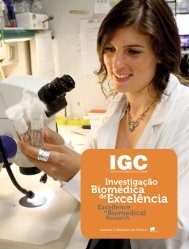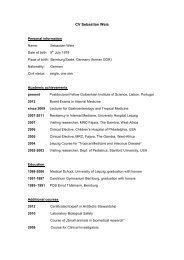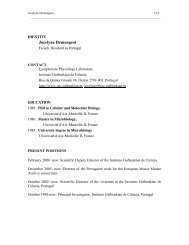organisation - the Instituto Gulbenkian de Ciência
organisation - the Instituto Gulbenkian de Ciência
organisation - the Instituto Gulbenkian de Ciência
- No tags were found...
Create successful ePaper yourself
Turn your PDF publications into a flip-book with our unique Google optimized e-Paper software.
DEVELOPMENT,<br />
EVOLUTION<br />
AND THE ENVIRONMENT<br />
Christen Mirth Principal Investigator<br />
PhD in Zoology, University of Cambridge, UK, 2002<br />
Post-doctoral associate, Department of Zoology, University of Wahsington, Seattle, USA<br />
Research Specialist, Janelia Farm Research Campus, HHMI, Ashburn, USA<br />
Principal Investigator at <strong>the</strong> IGC since 2010<br />
link to external website<br />
Our lab studies <strong>the</strong> regulation and evolution of environmentally-<strong>de</strong>pen<strong>de</strong>nt<br />
traits in species from <strong>the</strong> genus Drosophila. Recently, our efforts have focused<br />
on two traits that <strong>de</strong>pend on nutritional cues:<br />
1. Body size;<br />
2. Larval foraging behaviour.<br />
We use <strong>the</strong> genetic tools available in Drosophila melanogaster to dissect how environmental<br />
signals, like nutrition, regulate larval growth and foraging choices.<br />
By analysing <strong>the</strong> changes in <strong>the</strong>se mechanisms across species, we hope to i<strong>de</strong>ntify<br />
how <strong>the</strong>se environmentally-<strong>de</strong>pen<strong>de</strong>nt traits evolve to create species-specific<br />
differences in foraging behaviour and adult body size.<br />
GROUP MEMBERS<br />
Takashi Koyama (Post-doc)<br />
Marisa Oliveira (PhD Stu<strong>de</strong>nt)<br />
Cláudia Men<strong>de</strong>s (PhD Stu<strong>de</strong>nt, started in April)<br />
Sara Lennox (Technician)<br />
Marisa Rodrigues (Trainee)<br />
COLLABORATORS<br />
Alexan<strong>de</strong>r Shingleton (Department of Zoology, Michigan State University, USA)<br />
Élio Sucena (IGC, Portugal)<br />
Marta Zlatic (Janelia Farm Research Campus, Howard Hughes Medical<br />
Institute, USA)<br />
FUNDING<br />
Calouste <strong>Gulbenkian</strong> Foundation, Portugal<br />
NUTRITION-DEPENDENT REGULATION OF BODY SIZE<br />
IN Drosophila melanogaster<br />
Organisms of all phyla regulate <strong>the</strong>ir body size in response to a number of environmental<br />
factors, including nutrition. Both <strong>the</strong> rate of growth and <strong>the</strong> length of<br />
<strong>the</strong> growth period <strong>de</strong>termine final body size. Nutrition regulates growth rates<br />
via <strong>the</strong> insulin and target of rapamycin (TOR) pathways. In insects, a size-<strong>de</strong>pen<strong>de</strong>nt<br />
checkpoint, known as critical weight, <strong>de</strong>termines when growth ceases.<br />
Insulin and TOR signaling in <strong>the</strong> prothoracic gland (PG) regulates critical weight<br />
by controlling on <strong>the</strong> production of <strong>the</strong> steroid hormone ecdysone. Thus nutrition<br />
directly affects both <strong>the</strong> rate and duration of <strong>the</strong> growth period. We aim to<br />
un<strong>de</strong>rstand how nutrition regulates final body size by:<br />
1. Investigating how insulin/TOR controls <strong>the</strong> nutrition-<strong>de</strong>pen<strong>de</strong>nt syn<strong>the</strong>sis<br />
of ecdysone;<br />
2. Determine <strong>the</strong> role of ecdysone signalling on <strong>the</strong> growth and differentiation<br />
of <strong>the</strong> <strong>de</strong>veloping adult tissues.<br />
Two manuscripts are in preparations:<br />
Oliveira, M.M., Shingleton, A.W. & Mirth, C.K. (in preparation). How old are you?<br />
A new tool using gene patterning to characterise <strong>de</strong>velopmental time in Drosophila<br />
larvae.<br />
Mirth, C.K.,Tang,H.Y., Makhon-Moore, S., Salhadar, S., Riddiford, L.M. & Shingleton,<br />
A.W. (in preparation). Juvenile Hormone controls body size by regulating<br />
insulin signalling in Drosophila.<br />
THE ENVIRONMENTAL REGULATION AND EVOLUTION OF FORAGING<br />
STRATEGIES IN THE GENUS Drosophila<br />
The environment and evolution act to generate a vast diversity of foraging strategies<br />
in insects. We examine two aspects of foraging behaviour: how environmental<br />
cues interact with <strong>de</strong>velopment to regulate larval foraging behaviour in<br />
D. melanogaster and how behavioural suites evolve to produce differences in<br />
larval foraging strategies between species of <strong>the</strong> genus Drosophila.<br />
Our most recent efforts investigate <strong>the</strong> evolution of larval foraging behaviour<br />
using a collection of 47 species of Drosophila. To date, we have analysed all<br />
species for burrowing behaviour. We are continuing our exploration by characterising<br />
<strong>the</strong> array of behaviours observed when larvae come into contact on<br />
<strong>the</strong> surface of <strong>the</strong> food. Exploring <strong>the</strong>se behaviours allows us to generate a<br />
behavioural profile for each species.<br />
We use <strong>the</strong>se profiles to i<strong>de</strong>ntify closely related species exhibiting divergent<br />
behaviours. Our ultimate goal is to i<strong>de</strong>ntify genomic sites responsible for <strong>the</strong><br />
evolution of foraging strategies. A manuscript is in preparation:<br />
Rivera Alba, M., Kelstrup, H.C.P., Riddiford, L.M. & Mirth, C.K. (in preparation).<br />
The evolution of burrowing behaviour in fruit flies from <strong>the</strong> genus Drosophila.<br />
Knocking down FoxO and Usp in <strong>the</strong> prothoracic gland (PG) causes premature<br />
expression of Senseless (Sens) in wing discs of larvae starved of protein. A) A<br />
wing disc from a control larva (PG>). B) A wing disc from a larva in which FoxO is<br />
knocked down in <strong>the</strong> PG. C) A wing disc from a larva in which Usp is knocked down<br />
in <strong>the</strong> PG. D) A wing disc from a larva in which both FoxO and Usp are knocked<br />
down in <strong>the</strong> PG. Arrows point to Sens positive sensory organ precursors.<br />
IGC ANNUAL REPORT ‘11<br />
RESEARCH GROUPS<br />
52






